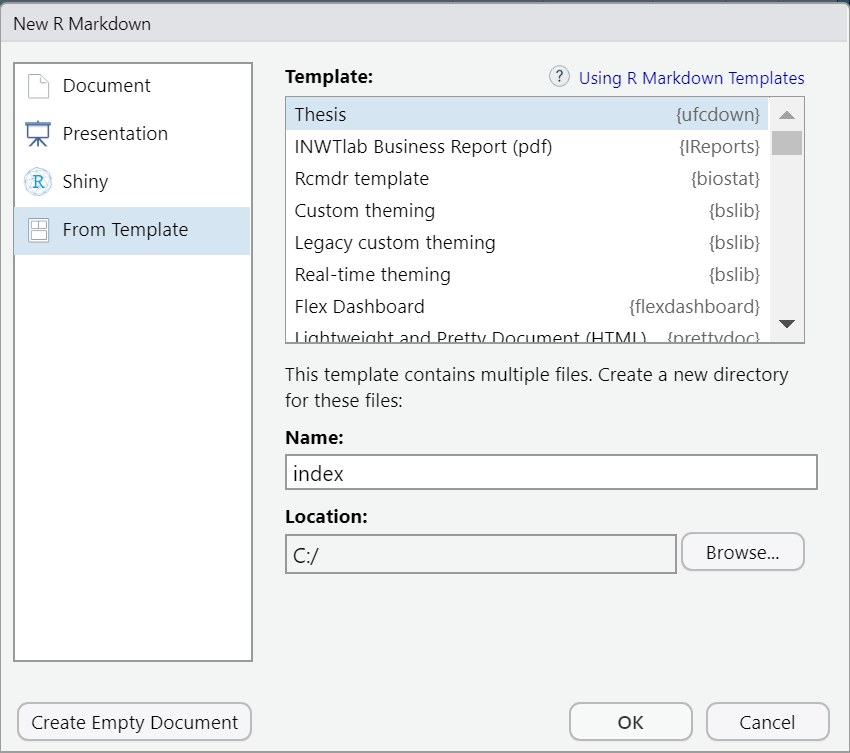This project was inspired by the
thesisdown package. De facto,
ufcdown (as well as thesisdown) is only a customization of the
bookdown package. ufcdown
customizes bookdown to the
UFC
format. Check out this
link
for other examples.
Currently, the PDF version is fully-functional. The gitbook, word and epub versions are developmental, have no templates behind them, and are essentially calls to the appropriate functions in bookdown.
If you are new to working with bookdown/rmarkdown, please read over
the documentation available in the gitbook template at
https://thesisdown.netlify.com/. This is also available below at
https://ismayc.github.io/thesisdown_book.
The current output for the four versions is here:
- PDF ( Generating LaTeX file is available here with other files at in the book directory.)
- Word
- ePub
- gitbook
Under the hood, the UFC LaTeX template on Overleaf is used to ensure that documents conform precisely to submission standards. At the same time, composition and formatting can be done using lightweight markdown syntax, and R code and its output can be seamlessly included using rmarkdown.
Using ufcdown has some prerequisites which are described below. To compile PDF documents using R, you are going to need to have LaTeX installed. By far the easiest way to install LaTeX on any platform is with the tinytex R package:
install.packages(c('tinytex', 'rmarkdown'))
tinytex::install_tinytex()
# after restarting RStudio, confirm that you have LaTeX with
tinytex:::is_tinytex() You may need to install a few extra LaTeX packages on your first attempt to knit as well. Here is one such example of how to do so:
tinytex::tlmgr_install("babel-portuges")
#> tlmgr update --all --self
#> tlmgr install babel-portugesTo use ufcdown from RStudio:
1) Ensure that you have already installed LaTeX and the fonts described
above, and are using the latest version of
RStudio. You can
use ufcdown without RStudio. For example, you can write the Rmd
files in your favourite text editor (e.g. Atom,
Notepad++). But RStudio is probably
the easiest tool for writing both R code and text in your thesis. It
also provides a nice way to build your thesis while editing. We’ll
proceed assuming that you have decided to use the RStudio workflow.
2) Install the bookdown and ufcdown packages. Note that
ufcdown is not available on CRAN at the moment and that’s why
install.packages("ufcdown") won’t work. Use
remotes::install_github() as shown below instead to install the
package.
if (!require("remotes"))
install.packages("remotes", repos = "http://cran.rstudio.org")
remotes::install_github("damarals/ufcdown")
# or, if you wish, install all the suggested packages:
remotes::install_github("damarals/ufcdown", dependencies = TRUE)Note that you may need to restart RStudio at this point for the following dialog to show up.
3) Use the New R Markdown dialog to select Thesis:
Note that this will currently only Knit if you name the directory
index as shown above.
4) After choosing which type of output you’d like in the YAML at the
top of index.Rmd, Knit the index.Rmd file to get the book in PDF
formats.
You need to edit the individual chapter R Markdown files to write your
thesis. It’s recommended that you version control your thesis using
GitHub if possible. RStudio can also easily sync up with GitHub to make
the process easier. While writing, you should git commit your work
frequently, after every major activity on your thesis. For example,
every few paragraphs or section of text, and after major step of
analysis development. You should git push at the end of each work
session before you leave your computer or change tasks. For a gentle,
novice-friendly guide to getting starting with using Git with R and
RStudio, see http://happygitwithr.com/.
To render your thesis into a PDF, open a powershell, terminal, git bash,
cmd, etc… in the same directory as the index.Rmd file and run the
make command. Tip: the make command can be given from the Rstudio
terminal (not console).
The make command is needed to correctly insert the glossary page. If
you are knitting (knit button) in Rstudio, the Thesis document in pdf
will be generated, but with the glossary page empty (blank page).
If you are using Windows, you can install GNU make with chocolatey,
a well-maintained package manager, which will add make to the global
path and runs on all CLIs (powershell, git bash, cmd, etc…) saving you a
ton of time in both maintenance and initial setup to get make running.
-
Install the chocolatey package manager for Windows compatible to Windows 7+ / Windows Server 2003+
-
Run
choco install makein powershell, terminal, git bash, cmd, etc…
The PDF file of your thesis (thesis.pdf) will be deposited in the same
directory of index.Rmd, by default.
The following components are ones you should edit to customize your thesis:
This is the main configuration file for your thesis. It determines what Rmd files are included in the output, and in what order. Arrange the order of your chapters in this file and ensure that the names match the names in your folders.
This file contains all the meta information that goes at the beginning of your document. You’ll need to edit this to put your name on the first page, the title of your thesis, etc.
The lib folder contains several style and .tex files like
glossario.tex and lista-de-simbolos.tex
These .tex files must be edited in latex format.
The misc folder contains files of various extensions to be used in the document, code files, pdfs, etc.
Specific style files for bibliographies should be stored here. A good source for citation styles is https://github.com/citation-style-language/styles#readme
These are the Rmd files for each chapter in your dissertation. Write your thesis in these. If you’re writing in RStudio, you may find the wordcount addin useful for getting word counts and readability statistics in R Markdown documents.
Store your bibliography (as bibtex files) here. We recommend using the citr addin and Zotero to efficiently manage and insert citations.
Store your figures and data here and reference them in your R Markdown files. See the bookdown book for details on cross-referencing items using R Markdown.

